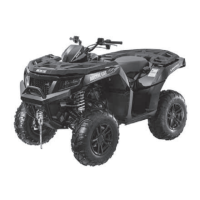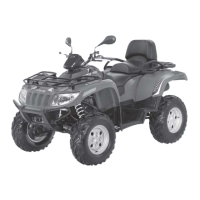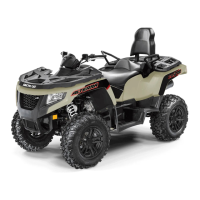Do you have a question about the Arctic Cat XR 700 and is the answer not in the manual?
Information on genuine parts, oil, and accessories for your ATV.
Guidelines for responsible ATV riding and respect for the sport and environment.
Emphasizes the ATV is not a toy and poses significant operating risks.
Provides critical safety warnings and statistics regarding ATV accidents and risks.
Information on sponsored ATV riding courses for skill development and safety.
Details important safety information conveyed through labels and hangtags on the ATV.
Risks of operating an ATV without certified training or instruction.
Importance of wearing helmets, eye protection, and protective clothing for safety.
Hazards of operating an ATV under the influence of alcohol or drugs.
Guidance on navigating hills, rough, or slippery terrain safely.
Proper procedures for loading cargo and towing to prevent accidents.
Precautions for crossing water obstacles and navigating terrain hazards.
Guidelines for using correct tires and engaging the differential lock.
Essential clothing and protective gear for safe ATV riding.
Pre-ride inspection of tires, wheels, controls, cables, and brakes.
Recommended items to carry for emergencies and survival on rides.
How body weight and balance affect ATV handling during turns.
Techniques for safely executing wide turns on an ATV.
Advanced techniques for mastering sharp turns on an ATV.
Safe methods for climbing hills, including weight shift and gear selection.
Techniques for safely descending hills, focusing on brake control.
Importance of understanding terrain, weather, and environmental factors.
Safety precautions for riding at night and avoiding paved surfaces.
Tips for trail riding, including visibility and leaving space for other riders.
Risks of substance use and impact of physical condition on safe riding.
Awareness of laws, regulations, and group riding dynamics.
A systematic approach to safe ATV operation and hazard assessment.
Responsibility for supervising and training inexperienced riders.
Guidelines for supervising experienced riders and familiarizing them with the ATV.
Step-by-step procedures for safely getting on and off the ATV.
Proper methods for starting, stopping, and warming up the ATV engine.
How to shift gears and apply brakes for safe operation and stopping.
How body weight and balance affect ATV handling during turns.
Techniques for safely executing wide turns on an ATV.
Advanced techniques for mastering sharp turns on an ATV.
Procedure for executing K-turns when stalling or maneuvering on hills.
Safe methods for climbing hills, including weight shift and gear selection.
Techniques for safely descending hills, focusing on brake control.
Techniques for avoiding obstacles and riding on slopes safely.
Guidelines for navigating obstacles and operating in reverse.
Procedures for parking on slopes and handling stalls while climbing.
Safety precautions for crossing water and roads.
Considerations for operating the ATV in cold weather conditions.
Location and importance of Vehicle Identification Number (VIN) and Engine Serial Number (ESN).
Explanation of ignition switch positions and basic control functions.
Information on throttle lever, limiter, and power steering system.
How to use and set the various displays on the LCD gauge.
List and explanation of diagnostic trouble codes for EFI system errors.
Information on the electric fuel pump, gas hoses, and checking oil level.
Proper use of the seat latch and guidelines for front/rear rack loading.
Safe practices for trailering and towing with the ATV.
Procedures for securing the ATV for transport.
Recommended gasoline, engine oil, and lubricant types.
Safe procedures and precautions for filling the ATV's gas tank.
Proper break-in period for new engines to ensure longevity and performance.
Procedure to burnish brake pads for optimal braking effectiveness.
A schedule for routine inspections, adjustments, and replacements.
Procedures for checking and maintaining the ATV's cooling system.
Inspection and adjustment of shock absorbers and cable lubrication.
Steps for changing engine oil and filter.
Inspecting and changing gear lubricant for the differential and drive.
Inspection of hydraulic hand brake, fluid, hoses, and pads.
Inspection of protective boots and maintenance of the rear foot brake.
Procedures for cleaning, charging, and maintaining the ATV battery.
Recommended methods for charging the ATV battery.
Safe procedures for jump-starting the ATV in an emergency.
Guidelines for tire selection, tread condition, and replacement.
Procedure for cleaning the muffler and spark arrester.
Steps for replacing headlight and taillight bulbs.
How to adjust headlight aim for optimal visibility.
Locating and checking fuses for electrical system issues.
Information on accessory power terminals and their limitations.
Location and maintenance of the tool kit and storage compartment.
Information on genuine parts, oil, and accessories for your ATV.
Guidelines for responsible ATV riding and respect for the sport and environment.
Emphasizes the ATV is not a toy and poses significant operating risks.
Provides critical safety warnings and statistics regarding ATV accidents and risks.
Information on sponsored ATV riding courses for skill development and safety.
Details important safety information conveyed through labels and hangtags on the ATV.
Risks of operating an ATV without certified training or instruction.
Importance of wearing helmets, eye protection, and protective clothing for safety.
Hazards of operating an ATV under the influence of alcohol or drugs.
Guidance on navigating hills, rough, or slippery terrain safely.
Proper procedures for loading cargo and towing to prevent accidents.
Precautions for crossing water obstacles and navigating terrain hazards.
Guidelines for using correct tires and engaging the differential lock.
Essential clothing and protective gear for safe ATV riding.
Pre-ride inspection of tires, wheels, controls, cables, and brakes.
Recommended items to carry for emergencies and survival on rides.
How body weight and balance affect ATV handling during turns.
Techniques for safely executing wide turns on an ATV.
Advanced techniques for mastering sharp turns on an ATV.
Safe methods for climbing hills, including weight shift and gear selection.
Techniques for safely descending hills, focusing on brake control.
Importance of understanding terrain, weather, and environmental factors.
Safety precautions for riding at night and avoiding paved surfaces.
Tips for trail riding, including visibility and leaving space for other riders.
Risks of substance use and impact of physical condition on safe riding.
Awareness of laws, regulations, and group riding dynamics.
A systematic approach to safe ATV operation and hazard assessment.
Responsibility for supervising and training inexperienced riders.
Guidelines for supervising experienced riders and familiarizing them with the ATV.
Step-by-step procedures for safely getting on and off the ATV.
Proper methods for starting, stopping, and warming up the ATV engine.
How to shift gears and apply brakes for safe operation and stopping.
How body weight and balance affect ATV handling during turns.
Techniques for safely executing wide turns on an ATV.
Advanced techniques for mastering sharp turns on an ATV.
Procedure for executing K-turns when stalling or maneuvering on hills.
Safe methods for climbing hills, including weight shift and gear selection.
Techniques for safely descending hills, focusing on brake control.
Techniques for avoiding obstacles and riding on slopes safely.
Guidelines for navigating obstacles and operating in reverse.
Procedures for parking on slopes and handling stalls while climbing.
Safety precautions for crossing water and roads.
Considerations for operating the ATV in cold weather conditions.
Location and importance of Vehicle Identification Number (VIN) and Engine Serial Number (ESN).
Explanation of ignition switch positions and basic control functions.
Information on throttle lever, limiter, and power steering system.
How to use and set the various displays on the LCD gauge.
List and explanation of diagnostic trouble codes for EFI system errors.
Information on the electric fuel pump, gas hoses, and checking oil level.
Proper use of the seat latch and guidelines for front/rear rack loading.
Safe practices for trailering and towing with the ATV.
Procedures for securing the ATV for transport.
Recommended gasoline, engine oil, and lubricant types.
Safe procedures and precautions for filling the ATV's gas tank.
Proper break-in period for new engines to ensure longevity and performance.
Procedure to burnish brake pads for optimal braking effectiveness.
A schedule for routine inspections, adjustments, and replacements.
Procedures for checking and maintaining the ATV's cooling system.
Inspection and adjustment of shock absorbers and cable lubrication.
Steps for changing engine oil and filter.
Inspecting and changing gear lubricant for the differential and drive.
Inspection of hydraulic hand brake, fluid, hoses, and pads.
Inspection of protective boots and maintenance of the rear foot brake.
Procedures for cleaning, charging, and maintaining the ATV battery.
Recommended methods for charging the ATV battery.
Safe procedures for jump-starting the ATV in an emergency.
Guidelines for tire selection, tread condition, and replacement.
Procedure for cleaning the muffler and spark arrester.
Steps for replacing headlight and taillight bulbs.
How to adjust headlight aim for optimal visibility.
Locating and checking fuses for electrical system issues.
Information on accessory power terminals and their limitations.
Location and maintenance of the tool kit and storage compartment.
| Brand | Arctic Cat |
|---|---|
| Model | XR 700 |
| Category | Offroad Vehicle |
| Language | English |












